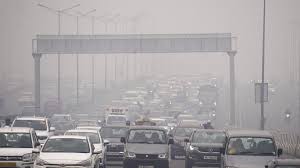PM2.5 Pollution and Health Risks in Northern India
Current Affairs NationalPosted by newadmin on 2025-03-04 09:04:05 |
Share: Facebook | Twitter | Whatsapp | Linkedin Visits: 44

Recent studies have shed light on the worsening air quality in Northern India, particularly in the Indo-Gangetic Plain. Research published in Nature Communications examines the sources and health effects of PM2.5, a fine particulate matter known for its harmful impact on public health. The study emphasizes the need to understand local emission sources and their contribution to air pollution.
Researchers analyzed PM2.5 samples from five locations, covering both urban and rural areas. Their findings revealed key components such as ammonium chloride and organic aerosols. In Delhi, vehicular emissions and residential heating emerged as major contributors, while areas outside the capital showed elevated levels of ammonium sulfate and aerosols resulting from biomass burning.
The study highlights the serious health risks associated with PM2.5 exposure. Its oxidative potential, which determines its ability to cause cellular damage, is primarily influenced by organic aerosols. These aerosols originate from the incomplete combustion of biomass and fossil fuels. Among the most critical contributors to this pollution are traffic emissions and residential fuel sources.
Seasonal variations play a significant role in aerosol concentration. While hydrocarbon-like organic aerosols remain persistently high throughout the year, primary organic aerosols peak during winter due to the increased use of cow dung for heating and cooking. In colder months, their concentrations can be up to ten times higher compared to warmer seasons.
Traffic emissions are another key factor in worsening PM2.5 pollution. Hydrocarbon-like organic aerosols from vehicles contribute significantly to the overall aerosol mass, with urban areas seeing their share rise to nearly 40%. This trend is especially evident during the warmer months.
A global comparison underscores the severity of the problem. The oxidative potential of PM2.5 in Indian cities is alarmingly high, surpassing levels recorded in cities across China and Europe by as much as five times. These findings reinforce the urgency of implementing measures to mitigate air pollution and protect public health in India.
Search
Categories
- Sports
- Business
- National
- Investments
- History
- Politics
- International
- Science & Technology
- Social Issues
- Disaster Management
- Current Affairs
- Events & Jobs
- మన పార్టీ
- మన నాయకత్వం
- మన విజయాలు
- డౌన్లోడ్స్
- మీడియా వనరులు
- కార్యకర్తలు
- రాజకీయం
- బిజినెస్
- సంపాదకీయం
- నవ్య
- చిత్ర జ్యోతి
- క్రీడలు
- జాతీయం
- తెలంగాణ
- తాజా వార్తలు
- Fast Check
- South
- Gallery
- Sunday Chronicle
- Hyderabad Chronicle
- Technology & Innovation
- Innovations and Initiatives
- బిజినెస్
- North East Skill Center News
- Government Schemes
- Entrepreneurship Support
- Employment Opportunities
- Skill Training Programs
- Education
- Startup Business
- Startup News
- Awards
- Community Services
- Fundraising Events
- Volunteer Services
- Health Initiatives
- సినిమా
- లైఫ్ స్టైల్
- క్రైం
- ట్రెండింగ్
- జాబ్స్
- అంతర్జాతీయo
- Market Buzz
- Awards
- Partners
- Products
- Press Releases
- News
- Departments
- Initiatives
- Resources
- Telangana IT Parks
- Press Releases
- News
- Airport News
- Sports
- Business
- Newtons Laws of Motion
- Karbonn in Business
- Investments in Karbonn
- Company quarterly sales
- Markets
- Auto News
- Industry
- Money
- Advertisements
- Stock target
- Company Updates
- Stock Market
- Company Sales
- Staffing and HR
- Constituency Assembly
- General News
- Srikalahasti Temple
- Bojjala Sudhir Reddy
- Products
- Industries
- Services & Trainings
- Tools & Resources
- Technology Integration
- Drug Seizures & Arrests
- Telangana Narcotics
- Law & Enforcement
- Rehabilitation
- Nationwide Drug Policing
- Nigeria Seizures
- Global Operations
- Drug Awareness
- Drug Enforcement Tech
- NCB Drug Seizures
- Judicial Crackdown
- India's Surveillance Tools
- Cross-Border Links
- Women Safety
- Cyber Crimes
- Drug Abuse
- Traffic & Road Safety
- Community Connect
- Public Safety Alerts
- Citizen Assistance
- Nellore City News
- Politics & Administration
- Events & Festivals
- Agriculture & Rural
- Business & Economy
- Health & Wellness
Recent News
- Honeybees on the Horizon: Understanding What Happens When Bees Go on Strike
- 'Ethnic Votes' Comment Deemed Racist and Unapologetic Fix Expected
- Google's AI Training Boost: Employees Must Prove AI Proficiency
- Top 10 Affordable Localities To Rent A House In Noida
- Office Commute Accidents Are Officially Protected Under ESI Benefits
- Rishabh Pant's Humble Beginnings Contrast With His Flamboyant Style
- Water Scare: Corporators Fight Bogus RO Plants as Viral Fevers Rampant
- Himachal Pradesh Achieves 99.3% Literacy Rate